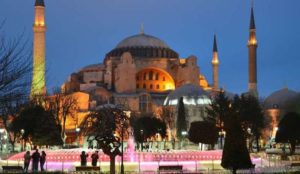
As much of the world is struggling against the coronavirus pandemic, the Islamists in Turkey appear to hold on to their everlasting agenda: Forced Islamization and violation of non-Muslims.
Adhan (Islamic call to prayer) and the Koranic verses Surat Al-Fath and Surat An Nasr were recited by two “imams” of the Hagia Sophia Church/museum, the pro-government newspaper Yeni Akit reported on March 23. The paper called the historic Cathedral the “Grand Hagia Sophia Mosque”.
“For the first time in history, acoustic test recordings of adhan and the Koran, which were recited with naked voice, were made in Hagia Sophia,” the paper said.
The paper went on to falsely claim that the “Hagia Sophia Mosque was unlawfully converted into a museum when it was a mosque.”
In fact, Hagia Sophia (Greek for “Holy Wisdom”) was built in the 6th century CE (532–537) under the direction of the Byzantine emperor Justinian I in Constantinople and remained the world’s largest cathedral for nearly 1,000 years until the Ottoman Turks invaded the city and looted it.
In 1930s, Turkey changed the city’s name to “Istanbul” and converted the mosque into a museum – another violation of the historic structure that was built as and meant to be a cathedral.
Referring to the Ottoman sultan Mehmet II, who invaded and captured the city in 1453, as the “Conquerer” (Fatih), and the Hagia Sophia as his “trust”, the paper asked:
“Will the longing for [Ottoman sultan] Fatih’s trust, Hagia Sophia, finally end?”
Why are some people so obsessively yearning for a Cathedral’s conversion to a mosque?
According to the 2019 statistics of Diyanet (Presidency of Religious Affairs), there are 84,684 mosques across Turkey, which means there is no shortage of mosques in the country.
“I can only think of one reason,” wrote the author Wesley J. Smith.
“As a shout of Islamic triumphalism. What a mistake that would be. Christians would rightly consider it an intentional insult. The international community would see it as an open rejection of its diversity agenda. Moreover, I think that a relatively secular Turkey acting so radically would demonstrate to the world that despite moderate Muslims’ many assurances to the contrary, contemporary Islam is intolerant in outlook, belligerent toward non-believers, and dangerously hegemonist in its intentions.”
What’s even more tragic is that there is no longer a strong Christian presence in Turkey that could get organized and oppose the abuses against the historic Cathedral.
The reason for that is the decades-long persecution of Christians in the country.
From 1913 to 1923, a genocide was carried out against Christians in Ottoman Turkey; in 1941-1942, there was an attempt to enlist and enslave all non-Muslim males in the Turkish military — including the elderly and mentally ill — to force them to work under horrendous conditions in labor battalions; in 1942, a Wealth Tax was imposed to eliminate Christians and Jews from the economy; in 1955, there was an anti-Greek pogrom in Istanbul; and in 1964, the remaining Greeks were forcefully expelled from Turkey. All of the above and more contributed to the ethnic cleansing of Christians in Turkey.
During all these abuses, the possessions of Christians were also targeted. The government and the private citizens of Turkey have seized and claimed ownership of the properties and lands of Christians that were murdered, deported or had to flee.
Author Raffi Bedrosyan explains:
“If not destroyed outright or left to deteriorate, the church and school buildings were converted into banks, mosques, state schools, community centers, stables, or warehouses. Armenian houses were taken over by local Turks and Kurds, or by Muslim refugee settlers from the Balkans. The Armenian economic assets such as farms, orchards, olive groves, stores, factories, mines became the foundation stones of the Turkish economy and the starting capital of most of the wealthy Turkish industrialists of today. The Turkish government continued the seizure of Armenian assets and the legalization of it up until the 2000s. With legislation brought in 1974, more than 1,400 legally obtained assets of the Istanbul Armenian charitable foundations since 1936, were declared illegal and seized by the state.”
The Greek, Assyrian and other Christian properties have also been exposed to a similar treatment at the hands of the government and Muslim citizens of Turkey.
Today, the latest target of Turkey’s aggression against Christian religious liberty is the Hagia Sophia Cathedral/museum, which is now a mosque.
However, many Muslims that are abusing the Hagia Sophia historic Cathedral and other Christian properties do not even see their actions as a type of abuse, violation, crime or aggression. To them, it is just the normal or even glorious way to treat Christians and other non-Muslims as well as their places of worship. And that is what makes political Islam the most perilous ideology that is extremely hard, if not impossible, to reach a common ground and achieve peaceful, meaningful coexistence with.
Uzay Bulut is a Turkish journalist formerly based in Ankara.



